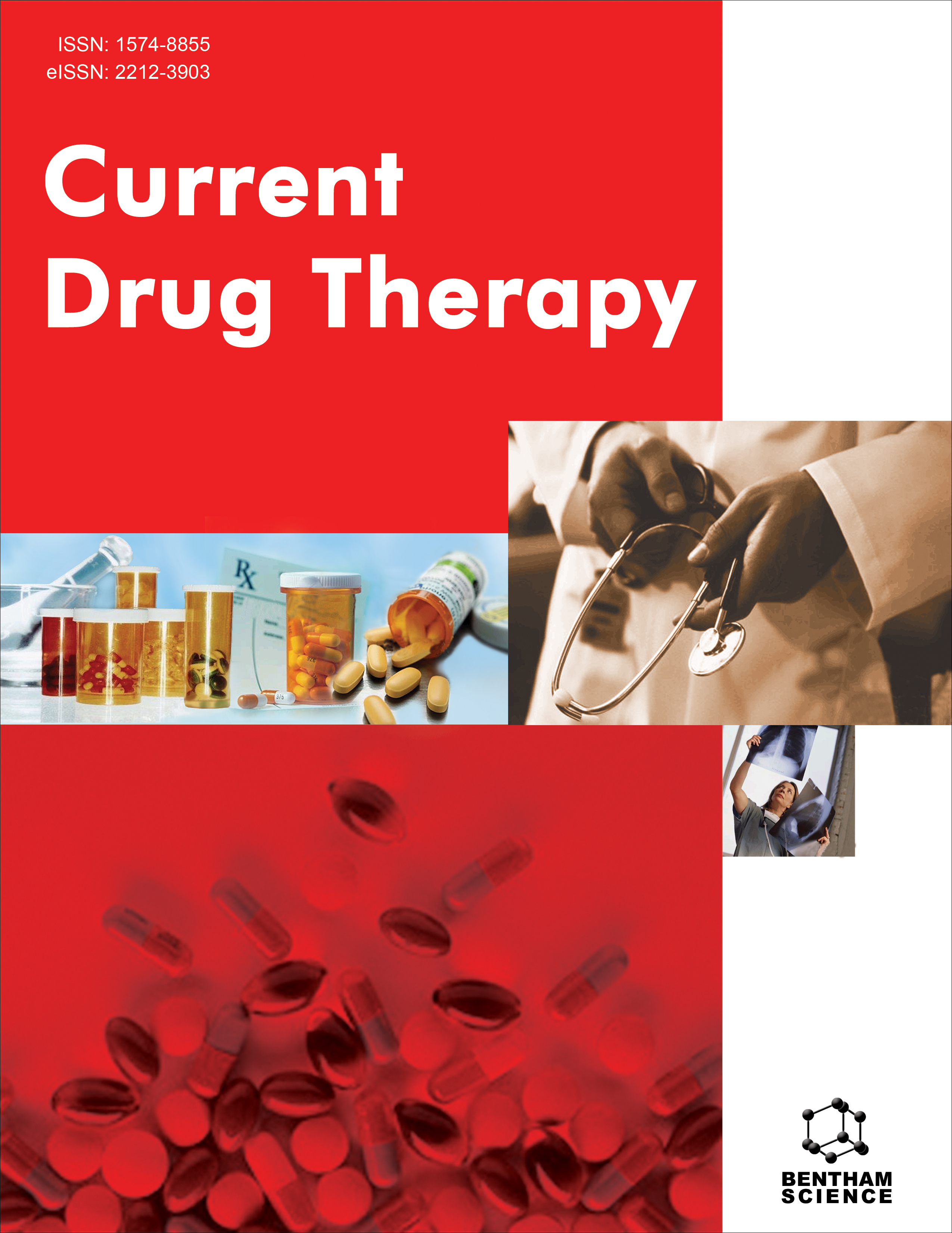- Home
- A-Z Publications
- Current Drug Therapy
- Previous Issues
- Volume 7, Issue 2, 2012
Current Drug Therapy - Volume 7, Issue 2, 2012
Volume 7, Issue 2, 2012
-
-
Vascular Endothelial Growth Factor (VEGF) Biochemistry and Development of Inhibitory Drugs
More LessAngiogenesis plays a critical role in human growth and development, as well as tissue repair and maintenance. Though angiogenesis can be stimulated by several metabolites and growth factors, vascular endothelial growth factor (VEGF) appears to be critical for all new vessel growth. VEGF includes several molecules that are classified according to structure and binding characteristics into the following groupings: VEGF Read More
-
-
-
Anti-Vascular Endothelial Growth Factor (VEGF) Treatment of Age- Related Macular Degeneration
More LessAge-related macular Degeneration (AMD) is the most common cause of vision loss in patients over the age of 65 years in industrialized nations. Though most patients with AMD have the non-exudative (dry) form, most severe vision loss is due to exudative (wet) macular degeneration. Exudative AMD is characterized by the abnormal growth of neovascular membranes from the choriocapillaris into the subretinal or sub-r Read More
-
-
-
Anti-VEGF Treatment of Diabetic Retinopathy
More LessBy Keye WongThe management of diabetic retinopathy has been guided for almost thirty years by results of the Diabetic Retinopathy Study (initially reported in 1976) and Early Treatment Diabetic Retinopathy Study (initially reported in 1985). The goal of therapy was to reduce the risk of severe visual loss in proliferative diabetic retinopathy and to reduce the risk of moderate visual loss in patients with clinically significant macular edema. Anti Read More
-
-
-
Anti-Vascular Endothelial Growth Factor Treatment in Retinal Vein Occlusions
More LessVascular endothelial growth factor (VEGF) is produced by the retina as a response to ischemia. In lower concentrations, VEGF induces retinal vascular hyperpermeability; in higher concentrations, intraocular neovascularization. Intraocular concentrations of VEGF after retinal vein occlusion (RVO) fall along a continuum. Therefore, most RVOs are, to some degree, ischemic, a revision of the dichotomous ischemic/ nonischemi Read More
-
-
-
Utility of Non-Conventional Applications of Anti-VEGF Treatment in Selected Retinal Diseases
More LessAuthors: Rebecca A. Manning, Charles P. Richards, Kishan Govind and Shree K. KurupThe use and indications of anti-vascular endothelial growth factors (VEGF) are rapidly expanding, evolving and undergoing refinement in retinal diseases. This manuscript attempts to perform a critical appraisal of the diaspora of limited information available on the non- traditional applications (outside of AMD, DR and vascular occlusive diseases) and synthesize a review. As with any newer drug, only longitudinal stu Read More
-
-
-
Anti-VEGF Treatment of Anterior Segment Disorders of the Eye
More LessThe cornea maintains avascularity by balancing angiogenic factors and anti-angiogenic agents. Stress on the cornea can disrupt this delicate equilibrium resulting in angiogenesis. Bevacizumab (Avastin®; Genentech, South San Francisco, CA) is a humanized monoclonal antibody which binds to all isoforms of vascular endothelial growth factor (VEGF)-A, thereby inhibiting angiogenesis. Recent studies have explored the ro Read More
-
-
-
Anti-VEGF Treatment of Glaucoma
More LessChallenges with surgical treatment of glaucoma are numerous and frequent, especially with the more complicated forms such as neovascular or uveitic glaucoma. Surgeries often fail which have driven the search for using a surgical adjunct to improve the outcomes and longevity of glaucoma procedures, while lowering their complication rates. VEGF levels have been found to be elevated in patients with both primary open angl Read More
-
-
-
Complications of Anti-Vascular Endothelial Growth Factor Drugs
More LessThe development of anti-vascular endothelial growth factor (VEGF) therapy is both revolutionary and unprecedented in the history of ophthalmology. In the past ophthalmic drugs have been the reformulations of previously well characterized systemic drugs. Anti-VEGF therapies for retinal diseases represent the first time that systemic and ocular complications are being initially defined by the ophthalmic profession. Read More
-
-
-
Risk Factors Associated with Resistance in CTX-M Producing E. coli Isolates
More LessCTX-M is the most frequent type of extended spectrum beta-lactamase. It is an important cause of anti-microbial resistance against cephalosporins and a recent concern in treating infections caused by Gram negative bacteria. Although Escherichia coli has become the major carrier of the genes, these enzymes were reported in many other bacterial species. The aim of this study was to determine risk factors associated wit Read More
-
-
-
“The Future Magic Bullet”: A Review of Pharmacological Activities of Ethyl Pyruvate and its Derivatives
More LessAuthors: Niraj S. Vyawahare, Varsha J. Bansode and Neeraj B. MunjalPyruvic acid is an organic acid found in most biological systems as an end product of the metabolism of sugar or starch and its carboxalate anion is known as pyruvate. Pyruvate enters in the Krebs cycle to generate the ATP. It is an effective scavenger of reactive oxygen species (ROS) and OH-. It also inhibits tumor necrosis factor-a production, iNOS (inducible nitric oxide synthase), and IL-6 (interleukin-6) levels. Pyruvates have inst Read More
-
Volumes & issues
-
Volume 20 (2025)
-
Volume 19 (2024)
-
Volume 18 (2023)
-
Volume 17 (2022)
-
Volume 16 (2021)
-
Volume 15 (2020)
-
Volume 14 (2019)
-
Volume 13 (2018)
-
Volume 12 (2017)
-
Volume 11 (2016)
-
Volume 10 (2015)
-
Volume 9 (2014)
-
Volume 8 (2013)
-
Volume 7 (2012)
-
Volume 6 (2011)
-
Volume 5 (2010)
-
Volume 4 (2009)
-
Volume 3 (2008)
-
Volume 2 (2007)
-
Volume 1 (2006)
Most Read This Month
Article
content/journals/cdth
Journal
10
5
false
en


